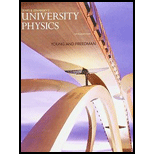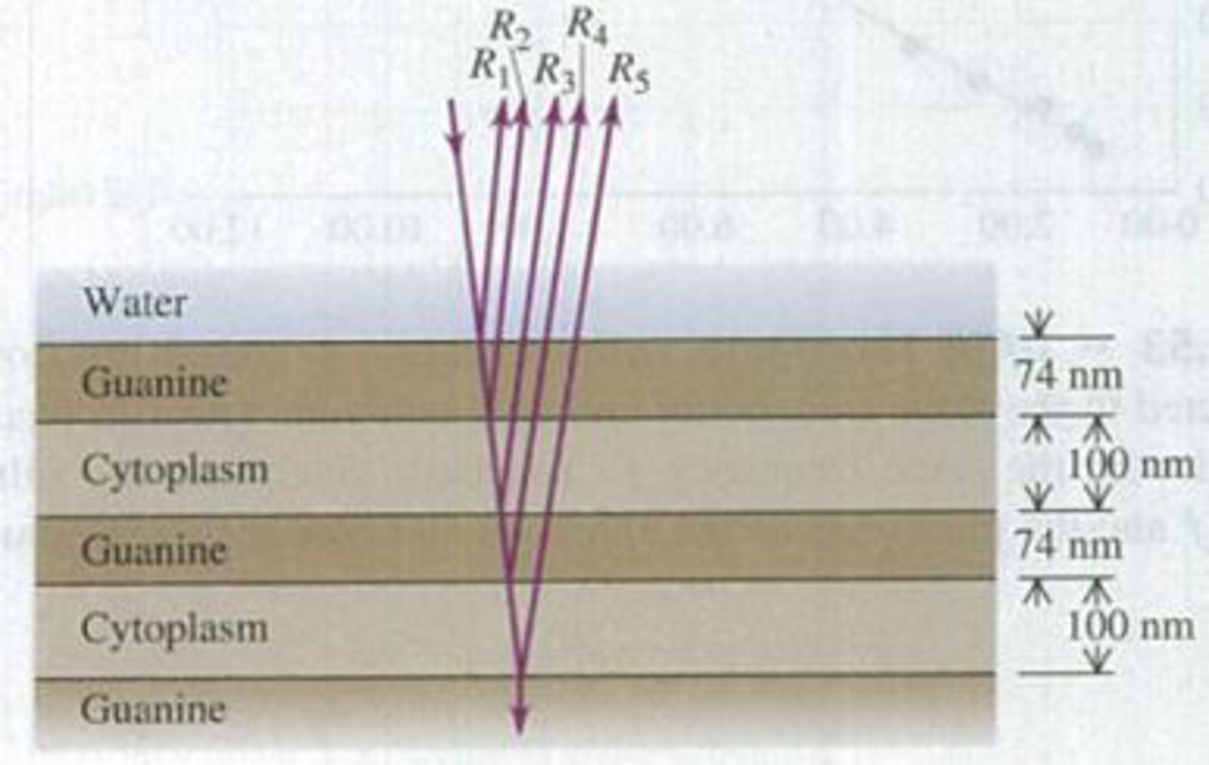
BIO Reflective Coatings and Herring. Herring and related fish have a brilliant silvery appearance that camouflages them while they are swimming in a sunlit ocean. The silveriness is due to platelets attached to the surfaces of these fish. Each platelet is made up of several alternating layers of crystalline guanine (n = 1.80) and of cytoplasm (n = 1.333, the same as water), with a guanine layer on the outside in contact with the surrounding water (Fig. P35.50). In one typical platelet, the guanine layers are 74 nm thick and the cytoplasm layers are 100 nm thick. (a) For light striking the platelet surface at normal incidence, for which vacuum wavelengths of visible light will all of the reflections R1, R2, R3, and R5, shown in Fig. P35.50, be approximately in phase? If white light is shone on this platelet, what color will be most strongly reflected (see Fig. 32.4)? The surface of a herring has very many platelets side by side with layers of different thickness, so that all visible wavelengths are reflected. (b) Explain why such a “stack” of layers is more reflective than a single layer of guanine with cytoplasm underneath. (A stack of five guanine layers separated by cytoplasm layers reflects more than 80% of incident
Figure P35.50

Want to see the full answer?
Check out a sample textbook solution
Chapter 35 Solutions
University Physics (14th Edition)
Additional Science Textbook Solutions
Essential University Physics (3rd Edition)
Sears And Zemansky's University Physics With Modern Physics
College Physics
Introduction to Electrodynamics
Applied Physics (11th Edition)
- A colloid consists of particles of one type of substance dispersed in another substance. Suspensions of electrically charged microspheres (microscopic spheres, such as polystyrene) in a liquid such as water can form a colloidal crystal when the microspheres arrange themselves in a regular repeating pattern under the influence of the electrostatic force. Colloidal crystals can selectively manipulate different wavelengths of visible light. Just as we can study crystalline solids by using Bragg reflection of x rays, we can study colloidal crystals through Bragg scattering of visible light from the regular arrangement of charged microspheres. Because the light is traveling through a liquid when it experiences the path differences that lead to constructive interference, it is the wavelength in the liquid that determines the angles at which Bragg reflections are seen. In one experiment, laser light with a wavelength in vacuum of 650 nm is passed through a sample of charged polystyrene…arrow_forwardA colloid consists of particles of one type of substance dispersed in another substance. Suspensions of electrically charged microspheres (microscopic spheres, such as polystyrene) in a liquid such as water can form a colloidal crystal when the microspheres arrange themselves in a regular repeating pattern under the influence of the electrostatic force. Colloidal crystals can selectively manipulate different wavelengths of visible light. Just as we can study crystalline solids by using Bragg reflection of x rays, we can study colloidal crystals through Bragg scattering of visible light from the regular arrangement of charged microspheres. Because the light is traveling through a liquid when it experiences the path differences that lead to constructive interference, it is the wavelength in the liquid that determines the angles at which Bragg reflections are seen. In one experiment, laser light with a wavelength in vacuum of 650 nm is passed through a sample of charged polystyrene…arrow_forwardThe coordinates of the four I atoms in the unit cell of KIO4 are (0,0,0), (0,1/2,1/2), (1/2,1/2,1/2), (1/2,0, 3/4). By calculating the phase of the I reflection in the structure factor, show that the I atoms contribute no net intensity to the (114) reflection.arrow_forward
- The skin reflects most visible and IR-A (near-infrared) radiation. The epidermis is highly absorbing at UV-B and UV-C wavelengths and at IR-B and IR-C wavelengths. True or Falsearrow_forward3. For a homogeneous dielectric medium with the refractive index of n(w), the corresponding Maxwell's equations in the frequency domain are given by V xE = iw Ho H; V ×À =-iwn² ɛ, È; v·È = 0; V · À = 0 %3D If k is the wavevector of a plane wave solution at the frequency w, please determine |k| in terms of W.arrow_forwardThe atmosphere of Jupiter is more than 1000 km thick. From the surface of Jupiter, would you expect to see a white Sun?arrow_forward
- Salt absorbs in the infrared. The complex dielectric constant at wavelength 60µm is -16.8 + i91.4. Calculate the absorption coefficient and the reflectivity at normal incidence at stated wavelength, knowing that 5. E = Er + iɛ¡ ɛ = n? n = n, + in; 2wnį a = 1 |n R = In + 1 where e is the dielectric constant, n is the refractive index, a is the absorption coefficient and R is the reflectivity.arrow_forwardThe atmosphere of Jupiter is more than 1000km thick .from the surface of Jupiter would you expect to see a white sun?arrow_forwardBuilding contractors often install double-glazed windows to prevent thermal energy (heat) from entering or exiting a building. In addition to being effective insulators, such windows present interesting optical effects. In the figure, a double-glazed window consists of two identical panes of glass (ng = 1.54), each yg = 22.0 mm thick, separated by an air gap of y₁ = 17.6 mm. Use na = 1.00 for the index of refraction of air. If light incident on the glass makes an angle of d = 40.00° with respect to the glass, find the shift in path Ax as the light enters the room. Ax = glass air glass mmarrow_forward
- The Bragg angle for a certain reflection from a powder specimen of copper is 47.75 degrees at a Temperature of 293 K and 46.60 degrees at 1273 K. Calculate the coefficient of linear thermal expansion of copper. O A. 1.91 X 106 K-1 В. 2.81 X 106 к1 O C. 1.91 X 105 K1 С. O D. 2.81 X 10-5 K-1arrow_forward5. Light can be described as an electromagnetic wave. The optical lenses also can be modeled as dielectric lenses which can be used to collimate electromagnetic fields. The following figure shows the circular surface in the left and planar surface in the right of the lens. Let E1(r, ø, z) = {10, -6, 0}, what must be the dielectric constant of the lens in order that E3(r, ø, z) in region 3 is parallel to the x-axis? y. To 45° 3arrow_forwarda) The magnitude of polarization is given as P=OXE. Show that the higher-order (nonlinear) terms can be expressed as P = €0 (X1E+X2E2+x3E3+ ...). Identify the linear and nonlinear terms. b) Explain the physical mechanism of phase-matching by considering four-wave mixing.arrow_forward
 Principles of Physics: A Calculus-Based TextPhysicsISBN:9781133104261Author:Raymond A. Serway, John W. JewettPublisher:Cengage Learning
Principles of Physics: A Calculus-Based TextPhysicsISBN:9781133104261Author:Raymond A. Serway, John W. JewettPublisher:Cengage Learning
